曼昆宏观经济学英文版26saving_investment
- 格式:ppt
- 大小:1.15 MB
- 文档页数:48

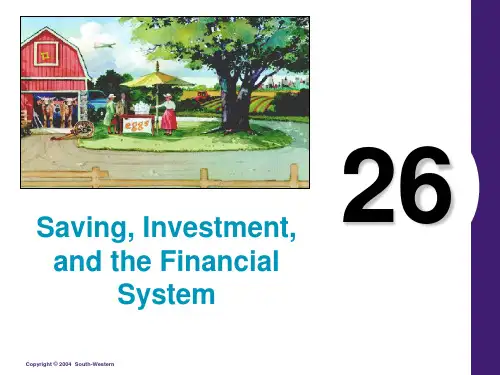
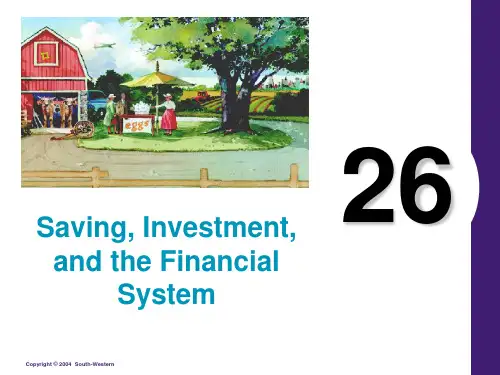
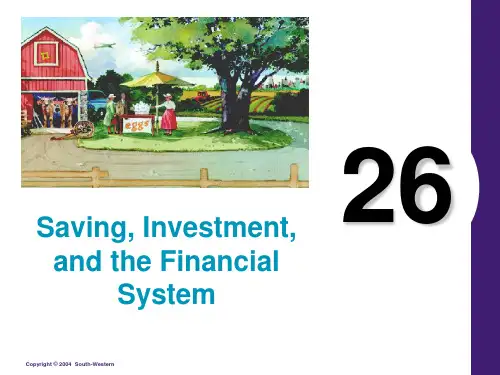
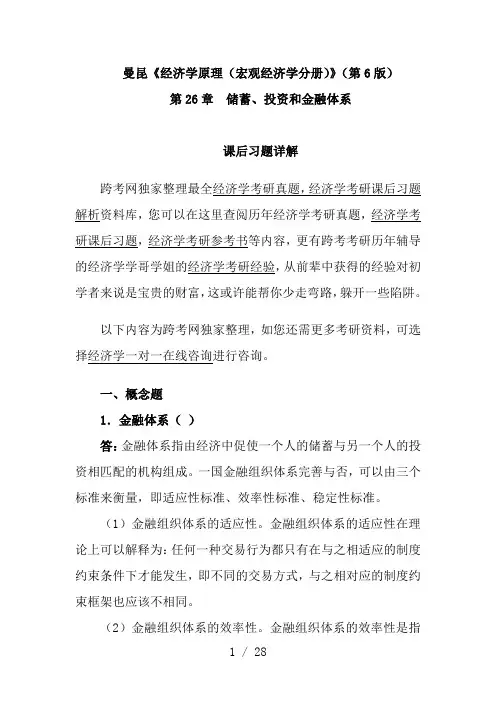
曼昆《经济学原理(宏观经济学分册)》(第6版)第26章储蓄、投资和金融体系课后习题详解跨考网独家整理最全经济学考研真题,经济学考研课后习题解析资料库,您可以在这里查阅历年经济学考研真题,经济学考研课后习题,经济学考研参考书等内容,更有跨考考研历年辅导的经济学学哥学姐的经济学考研经验,从前辈中获得的经验对初学者来说是宝贵的财富,这或许能帮你少走弯路,躲开一些陷阱。
以下内容为跨考网独家整理,如您还需更多考研资料,可选择经济学一对一在线咨询进行咨询。
一、概念题1.金融体系()答:金融体系指由经济中促使一个人的储蓄与另一个人的投资相匹配的机构组成。
一国金融组织体系完善与否,可以由三个标准来衡量,即适应性标准、效率性标准、稳定性标准。
(1)金融组织体系的适应性。
金融组织体系的适应性在理论上可以解释为:任何一种交易行为都只有在与之相适应的制度约束条件下才能发生,即不同的交易方式,与之相对应的制度约束框架也应该不相同。
(2)金融组织体系的效率性。
金融组织体系的效率性是指特定的金融组织体系能够保证金融交易活动低成本地顺利进行和储蓄向投资转化的程度。
(3)金融组织体系的稳定性。
金融组织体系的稳定性是指金融组织体系在保证金融稳定均衡、协调和有序运行等方面的能力状态。
2.金融市场()答:金融市场指资金供求双方运用各种金融工具,通过各种途径实现货币借贷和资金融通的交易活动的总称。
其含义有广义和狭义之分。
广义是指金融机构与客户之间、各金融机构之间、客户与客户之间所有以资金商品为交易对象的金融交易,包括存款、贷款、信托、租赁、保险、票据抵押与贴现、股票债券买卖等全部金融活动。
狭义则一般限定在以票据和有价证券为交易对象的融资活动范围之内。
3.债券()答:债券指由筹资者(即债务人)向投资者(即债权人)出具的、承诺在一定时期支付利息和到期归还本金的债务凭证。
它是表明债权债务关系的有价证券。
对债券发行人来说,它是一种债务,是按照约定条件(包括期限、利率、本息偿还方式等)支付利息和偿还本金的书面承诺;对债券持有人来说,它是一种债权,是按照约定条件要求发行人付息还本的权利。
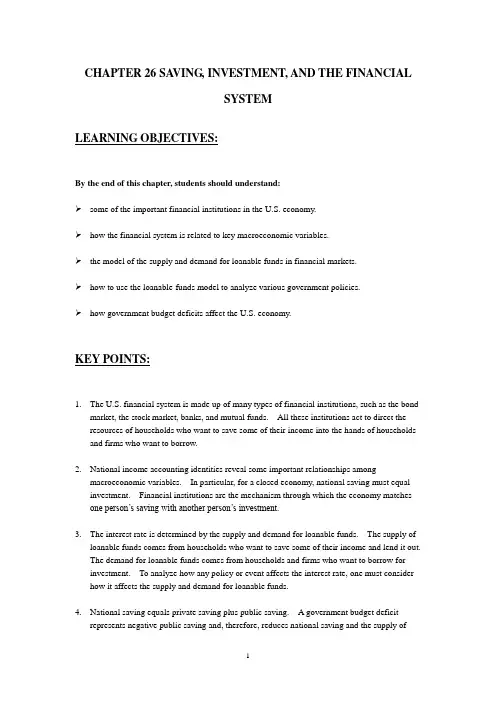
CHAPTER 26 SA VING, INVESTMENT, AND THE FINANCIALSYSTEMLEARNING OBJECTIVES:By the end of this chapter, students should understand:➢some of the important financial institutions in the U.S. economy.➢how the financial system is related to key macroeconomic variables.➢the model of the supply and demand for loanable funds in financial markets.➢how to use the loanable-funds model to analyze various government policies.➢how government budget deficits affect the U.S. economy.KEY POINTS:1.The U.S. financial system is made up of many types of financial institutions, such as the bondmarket, the stock market, banks, and mutual funds. All these institutions act to direct the resources of households who want to save some of their income into the hands of households and firms who want to borrow.2.National income accounting identities reveal some important relationships amongmacroeconomic variables. In particular, for a closed economy, national saving must equal investment. Financial institutions are the mechanism through which the economy matches one person’s saving with another person’s investment.3.The interest rate is determined by the supply and demand for loanable funds. The supply ofloanable funds comes from households who want to save some of their income and lend it out.The demand for loanable funds comes from households and firms who want to borrow for investment. To analyze how any policy or event affects the interest rate, one must consider how it affects the supply and demand for loanable funds.4.National saving equals private saving plus public saving. A government budget deficitrepresents negative public saving and, therefore, reduces national saving and the supply ofloanable funds available to finance investment. When a government budget deficit crowds out investment, it reduces the growth of productivity and GDP.OUTLINE:I. Definition of financial system: the group of institutions in the economy that help tomatch one person’s saving with another person’s investment.II. Financial Institutions in the U.S. EconomyA. Financial Markets1. Definition of financial markets: financial institutions through whichsavers can directly provide funds to borrowers.2. The Bond Marketa. Definition of bond: a certificate of indebtedness.b. A bond identifies the date of maturity and the rate of interestthat will be paid periodically until the loan matures.c. One important characteristic that determines a bond’s value isits term. The term is the length of time until the bond matures.All else equal, long-term bonds pay higher rates of interest thanshort-term bonds.d.Another important characteristic of a bond is its credit risk,which is the probability that the borrower will fail to pay someof the interest or principal. All else equal, the more risky abond is, the higher its interest rate.e. A third important characteristic of a bond is its tax treatment.For example, when state and local governments issue bonds(called municipal bonds), the interest income earned by theholders of these bonds is not taxed by the federal government.This makes these bonds more attractive; thus, lowering theinterest rate needed to entice people to buy them.3. The Stock Marketa. Definition of stock: a claim to partial ownership in a firm.b. The sale of stock to raise money is called equity finance; thesale of bonds to raise money is called debt finance.c. Stocks are sold on organized stock exchanges (such as the NewYork Stock Exchange or NASDAQ) and the prices of stocks aredetermined by supply and demand.d. The price of a stock generally reflects the perception of acompany’s future profitability.e. A stock index is computed as an average of a group of stockprices.B. Financial Intermediaries1. Definition of financial intermediaries: financial institutions throughwhich savers can indirectly provide funds to borrowers.2. Banksa. The primary role of banks is to take in deposits from peoplewho want to save and then lend them out to others who want toborrow.b. Banks pay depositors interest on their deposits and chargeborrowers a higher rate of interest to cover the costs of runningthe bank and provide the bank owners with some amount ofprofit.c. Banks also play another important role in the economy byallowing individuals to use checking deposits as a medium ofexchange.3. Mutual Fundsa. Definition of mutual fund: an institution that sells shares tothe public and uses the proceeds to buy a portfolio of stocksand bonds.b. The primary advantage of a mutual fund is that it allowsindividuals with small amounts of money to diversify.c.Mutual funds called “index funds” buy all of the stocks of a givenstock index. These funds have generally performed better thanfunds with active fund managers. This may be true because theytrade stocks less frequently and they do not have to pay the salariesof fund managers.C. Summing Up1. There are many financial institutions in the U.S. economy.2. These institutions all serve the same goal—moving funds from savers toborrowers.III.Saving and Investment in the National Income AccountsA. Some Important Identities1. Remember that GDP can be divided up into four components:consumption, investment, government purchases, and net exports.2. We will assume that we are dealing with a closed economy (an economythat does not engage in international trade or international borrowingand lending). This implies that GDP can now be divided into onlythree components:3. To isolate investment, we can subtract C and G from both sides:4. The left-hand side of this equation (Y–C–G) is the total income in theeconomy after paying for consumption and government purchases.This amount is called national saving.5. Definition of national saving (saving): the total income in theeconomy that remains after paying for consumption andgovernment purchases.6. Substituting saving (S) into our identity gives us:7. This equation tells us that saving equals investment.8. Let’s go back to our definition of national saving once aga in:9. We can add taxes (T) and subtract taxes (T):10. The first part of this equation (Y–T–C) is called private saving; thesecond part (T–G) is called public saving.a. Definition of private saving: the income that householdshave left after paying for taxes and consumption.b. Definition of public saving: the tax revenue that thegovernment has left after paying for its spending.c. Definition of budget surplus: an excess of tax revenue overgovernment spending.d.Definition of budget deficit: a shortfall of tax revenue fromgovernment spending.Note: The important point to make here is that with a government budget deficit, public saving is negative and the public sector is thus “dissaving.” To make up for this shortfall, it must go to the loanable funds market and borrow the money. This will reduce the supply of loanable funds available for investment.11. The fact that S = I means that for the economy as a whole saving mustbe equal to investment.a. The bond market, the stock market, banks, mutual funds, andother financial markets and institutions stand between the twosides of the S = I equation.b. These markets and institutions take in the nation's saving anddirect it to the nation's investment.B. The Meaning of Saving and Investment1.In macroeconomics, investment refers to the purchase of new capital,such as equipment or buildings.Note: You will have to keep reminding yourself what the term “investment” means to macroeconomists. Outside of the economics pro fession, most people use the terms “saving” and “investing” interchangeably.2. If an individual spends less than he earns and uses the rest to buy stocksor mutual funds, economists call this saving.IV. The Market for Loanable FundsA. Definition of market for loanable funds: the market in which those who wantto save supply funds and those who want to borrow to invest demand funds.B.Supply and Demand for Loanable FundsFigure 11. The supply of loanable funds comes from those who spend less thanthey earn. The supply can occur directly through the purchase of somestock or bonds or indirectly through a financial intermediary.2. The demand for loans comes from households and firms who wish toborrow funds to make investments. Families generally invest in newhouses while firms may borrow to purchase new equipment or to buildfactories.3. The price of a loan is the interest rate.a. All else equal, as the interest rate rises, the quantity of loanablefunds supplied will increase.b.All else equal, as the interest rate rises, the quantity of loanablefunds demanded will fall.4. At equilibrium, the quantity of funds demanded is equal to the quantityof funds supplied.a. If the interest rate in the market is greater than the equilibriumrate, the quantity of funds demanded would be smaller than thequantity of funds supplied. Lenders would compete forborrowers, driving the interest rate down.b.If the interest rate in the market is less than the equilibrium rate,the quantity of funds demanded would be greater than thequantity of funds supplied. The shortage of loanable fundswould encourage lenders to raise the interest rate they charge.5.The supply and demand for loanable funds depends on the real (ratherthan nominal) interest rate because the real rate reflects the true return to savingand the true cost of borrowing.C. Policy 1: Saving IncentivesFigure 21. Savings rates in the United States are relatively low when comparedwith other countries such as Japan and Germany.2. Suppose that the government changes the tax code to encourage greatersaving.a. This will cause an increase in saving, shifting the supply ofloanable funds to the right.b. The equilibrium interest rate will fall and the equilibriumquantity of funds will rise.3. Thus, the result of the new tax laws would be a decrease in theequilibrium interest rate and greater saving and investment.E. Policy 2: Investment IncentivesFigure 31. Suppose instead that the government passed a new law lowering taxesfor any firm building a new factory or buying a new piece of equipment(through the use of an investment tax credit).a. This will cause an increase in investment, causing the demandfor loanable funds to shift to the right.b. The equilibrium interest rate will rise, and the equilibriumquantity of funds will increase as well.2.Thus, the result of the new tax laws would be an increase in theequilibrium interest rate and greater saving and investment.F. Policy 3: Government Budget Deficits and SurplusesFigure 4Figure 41. A budget deficit occurs if the government spends more than it receivesin tax revenue.2. This implies that public saving (T – G) falls which will lower nationalsaving.a. The supply of loanable funds will shift to the left.b. The equilibrium interest rate will rise, and the equilibriumquantity of funds will decrease.3. When the interest rate rises, the quantity of funds demanded forinvestment purposes falls.4. Definition of crowding out: a decrease in investment that resultsfrom government borrowing.5. When the government reduces national saving by running a budgetdeficit, the interest rate rises and investment falls.ernment budget surpluses work in the opposite way. The supply ofloanable funds increases, the equilibrium interest rate falls, and investment rises.7. Case Study: The History of U.S. Government DebtFigure 5Figure 5a. Figure 5 shows the debt of the U.S. government expressed as apercentage of GDP. In recent years, government debt has beenabout 50 percent of GDP.b. Throughout history, the primary cause of fluctuations ingovernment debt has been wars. However, the U.S. debt alsoincreased substantially during the 1980s when taxes were cutbut government spending was not.c. By the late 1990s, the debt to GDP ratio began declining due tobudget surpluses.d. As of 2002, the Congressional Budget Office was projectingthat the debt-GDP ratio would decline over the next decade toreach 15 percent in 2012.。
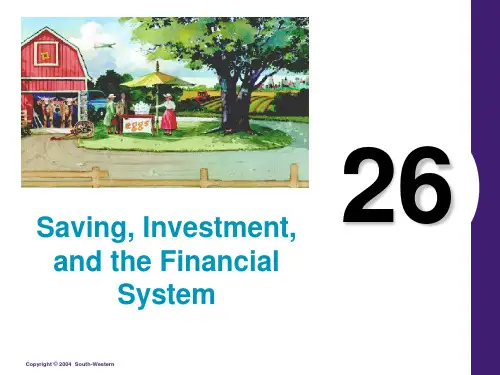
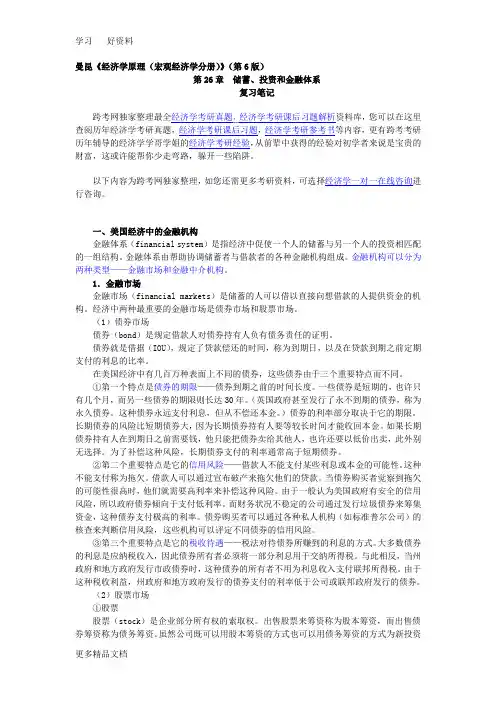
曼昆《经济学原理(宏观经济学分册)》(第6版)第26章储蓄、投资和金融体系复习笔记跨考网独家整理最全经济学考研真题,经济学考研课后习题解析资料库,您可以在这里查阅历年经济学考研真题,经济学考研课后习题,经济学考研参考书等内容,更有跨考考研历年辅导的经济学学哥学姐的经济学考研经验,从前辈中获得的经验对初学者来说是宝贵的财富,这或许能帮你少走弯路,躲开一些陷阱。
以下内容为跨考网独家整理,如您还需更多考研资料,可选择经济学一对一在线咨询进行咨询。
一、美国经济中的金融机构金融体系(financial system)是指经济中促使一个人的储蓄与另一个人的投资相匹配的一组结构。
金融体系由帮助协调储蓄者与借款者的各种金融机构组成。
金融机构可以分为两种类型——金融市场和金融中介机构。
1.金融市场金融市场(financial markets)是储蓄的人可以借以直接向想借款的人提供资金的机构。
经济中两种最重要的金融市场是债券市场和股票市场。
(1)债券市场债券(bond)是规定借款人对债券持有人负有债务责任的证明。
债券就是借据(IOU),规定了贷款偿还的时间,称为到期日,以及在贷款到期之前定期支付的利息的比率。
在美国经济中有几百万种表面上不同的债券,这些债券由于三个重要特点而不同。
①第一个特点是债券的期限——债券到期之前的时间长度。
一些债券是短期的,也许只有几个月,而另一些债券的期限则长达30年。
(英国政府甚至发行了永不到期的债券,称为永久债券。
这种债券永远支付利息,但从不偿还本金。
)债券的利率部分取决于它的期限。
长期债券的风险比短期债券大,因为长期债券持有人要等较长时间才能收回本金。
如果长期债券持有人在到期日之前需要钱,他只能把债券卖给其他人,也许还要以低价出卖,此外别无选择。
为了补偿这种风险,长期债券支付的利率通常高于短期债券。
②第二个重要特点是它的信用风险——借款人不能支付某些利息或本金的可能性。
这种不能支付称为拖欠。

本讲主要内容第25章生产与经济增长第26章储蓄、投资和金融体系第27章基本金融工具第28章失业与自然失业率15:192Saving, Investment, andthe Financial System储蓄、投资与金融体系2615:193金融体系•金融体系由经济中把一个人的储蓄与另一个人的投资相匹配的机构组成。
•它把经济的稀缺资源从储蓄者手中转移到借贷者手中。
15:194美国经济中的金融机构•金融体系由帮助协调储蓄者与借贷者的各种金融机构所组成。
•金融机构可以分为两种类型:金融市场和金融中介机构。
15:195美国经济中的金融机构•Financial Markets 金融市场 Stock Market 股票市场Bond Market 债券市场•Financial Intermediaries金融中介机构Banks 银行Mutual Funds 共同基金15:196美国经济中的金融机构•金融市场——想储蓄的人直接向想借款的人提供资金的机构。
•金融中介机构——储蓄者可以通过它间接地向借款者提供资金的金融机构。
15:197金融市场•债券市场–债券——一种债务证明书,规定了借款人向债券持有人的负债责任。
–债券特点•期限:债券到期之前的时间长度。
•信用风险:借款者不能支付某些利息或本金的可能性。
•税收待遇:税法对待债券所赚到的利息的方式。
–市政债券利息免征联邦所得税。
15:198金融市场•股票市场–股票代表企业的所有权,所以也代表对所获得利润的索取权。
–出售股票来筹资称为股本筹资。
•与债券相比,股票的风险高,潜在收益也高。
–美国经济中最重要的股票交易所是纽约股票交易所、美国股票交易所和纳斯达克(NASDAQ)。
15:199股票市场大多数报纸的股票栏目提供以下信息:•价格(每股)•交易量(股票销售的量)•股利(付给股票持有人的利润)•价格-每股赢利率(P/E)15:1910金融中介机构•金融中介机构——储蓄者可以通过它间接地向借款者提供资金的金融机构。
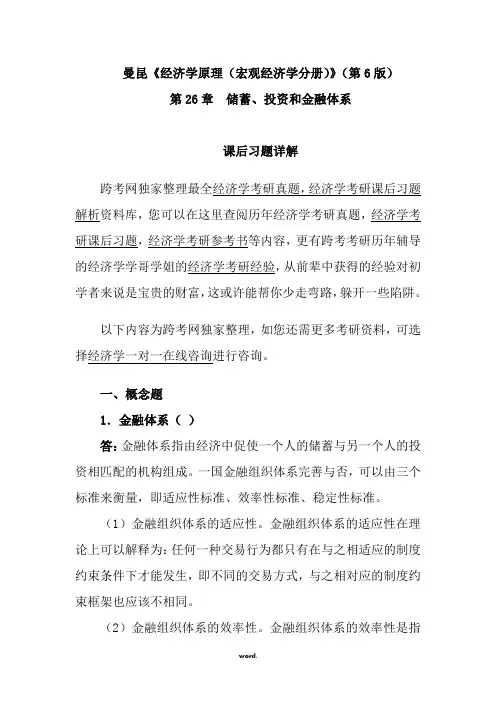
曼昆《经济学原理(宏观经济学分册)》(第6版)第26章储蓄、投资和金融体系课后习题详解跨考网独家整理最全经济学考研真题,经济学考研课后习题解析资料库,您可以在这里查阅历年经济学考研真题,经济学考研课后习题,经济学考研参考书等内容,更有跨考考研历年辅导的经济学学哥学姐的经济学考研经验,从前辈中获得的经验对初学者来说是宝贵的财富,这或许能帮你少走弯路,躲开一些陷阱。
以下内容为跨考网独家整理,如您还需更多考研资料,可选择经济学一对一在线咨询进行咨询。
一、概念题1.金融体系()答:金融体系指由经济中促使一个人的储蓄与另一个人的投资相匹配的机构组成。
一国金融组织体系完善与否,可以由三个标准来衡量,即适应性标准、效率性标准、稳定性标准。
(1)金融组织体系的适应性。
金融组织体系的适应性在理论上可以解释为:任何一种交易行为都只有在与之相适应的制度约束条件下才能发生,即不同的交易方式,与之相对应的制度约束框架也应该不相同。
(2)金融组织体系的效率性。
金融组织体系的效率性是指特定的金融组织体系能够保证金融交易活动低成本地顺利进行和储蓄向投资转化的程度。
(3)金融组织体系的稳定性。
金融组织体系的稳定性是指金融组织体系在保证金融稳定均衡、协调和有序运行等方面的能力状态。
2.金融市场()答:金融市场指资金供求双方运用各种金融工具,通过各种途径实现货币借贷和资金融通的交易活动的总称。
其含义有广义和狭义之分。
广义是指金融机构与客户之间、各金融机构之间、客户与客户之间所有以资金商品为交易对象的金融交易,包括存款、贷款、信托、租赁、保险、票据抵押与贴现、股票债券买卖等全部金融活动。
狭义则一般限定在以票据和有价证券为交易对象的融资活动范围之内。
3.债券()答:债券指由筹资者(即债务人)向投资者(即债权人)出具的、承诺在一定时期支付利息和到期归还本金的债务凭证。
它是表明债权债务关系的有价证券。
对债券发行人来说,它是一种债务,是按照约定条件(包括期限、利率、本息偿还方式等)支付利息和偿还本金的书面承诺;对债券持有人来说,它是一种债权,是按照约定条件要求发行人付息还本的权利。
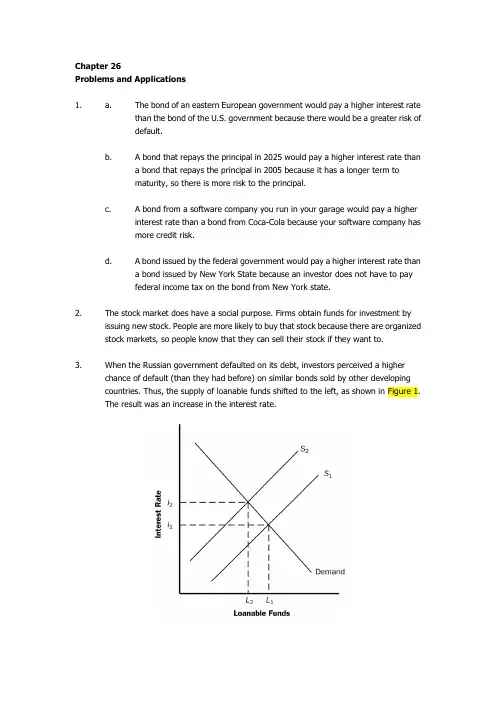
Chapter 26Problems and Applicat ions1. a. The bond of an eastern European government would pay a higher interest ratethan the bond of the U.S. government because there would be a greater risk ofdefault.b. A bond that repays the principal in 2025 would pay a higher interest rate thana bond that repays the principal in 2005 because it has a longer term tomaturity, so there is more risk to the principal.c. A bond from a software compa ny you run in your garage would pay a higherinterest rate than a bond from Coca-Cola because your software company hasmore credit risk.d. A bond issued by the federal government would pay a higher interest rate thana bond issued by New York State because an investor does not have to payfederal income tax on the bond from New York state.2. The stock market does have a social purpose. Firms obtain funds for investment byissuing new stock. People are more likely to buy that stock because there are organized stock markets, so people know that they can sell their stock if they want to.3. When the Russian government defaulted on its debt, investors perceived a higherchance of default (than they had before) on similar bonds sold by other developingcountries. Thus, the supply of loanable funds shifted to the left, as shown in Figure 1.The result was an increase in the interest rate.Figure 14. Companies encourage their employees to hold stock in the company because it givesthe employees the incentive to care about the firm’s profits, not just their own salary.Then, if employees see waste or see areas in which the firm can improve, they will take actions that benefit the company because they know the value of their stock will rise asa result. It also gives employees an additional incentive to work hard, knowing that ifthe firm does well, they will profit.But from an employee’s point of view, owning stock in the company for which she or he works can be risky. The emp loyee’s wages or salary is already tied to how well the firm performs. If the firm has trouble, the employee could be laid off or have her or hissalary reduced. If the employee owns stock in the firm, then there is a doublewhammy−the employee is unemployed or gets a lower salary and the value of thestock falls as well. So owning stock in your own company is a very risky proposition.Most employees would be better off diversifying−owning stock or bonds in othercompanies−so their fortunes would not depend so much on the firm for which theywork.5. To a macroeconomist, saving occurs when a person’s income exceeds his consumption,while investment occurs when a person or firm purchases new capital, such as a house or business equipment.a. When your family takes out a mortgage and buys a new house, that isinvestment because it is a purchase of new capital.b. When you use your $200 paycheck to buy stock in AT&T, that is savingbecause your income of $200 is not being spent on consumption goods.c. When your roommate earns $100 and deposits it in her account at a bank, thatis saving because the money is not spent on consumption goods.d. When you borrow $1,000 from a bank to buy a car to use in your pizza-deliverybusiness, that is investment because the car is a capital good.6. Given that Y = 8, T = 1.5, S priv ate = 0.5 = Y −T − C, S public = 0.2 = T − G.Because S private = Y − T − C, then rearranging gives C = Y − T −S private= 8 − 1.5 − 0.5 = 6.Because S public = T − G, then rearranging gives G = T − S public= 1.5 − 0.2 = 1.3.Because S = national saving = S priv ate + S public = 0.5 + 0.2 = 0.7.Finally, because I = investment = S, I = 0.7.7. a. If interest rates increase, the costs of borrowing money to build the factorybecome higher, so the returns from building the new plant may not besufficient to cover the costs. Thus, higher interest rates make it less likely thatIntel will build the new factory.b. Even if Intel uses its own funds to finance the factory, the rise in interest ratesstill matters. There is an opportunity cost on the use of the funds. Instead ofinvesting in the factory, Intel could invest the money in the bond market toearn the higher interest rate available there. Intel will compare its potentialreturns from building the factory to the potential returns from the bond market.If interest rates rise, so that bond market returns rise, Intel is again less likelyto invest in the factory.Figure 28. a. Figure 2 illustrates the effect of the $20 billion increase in governmentborrowing. Initially, the supply of loanable funds is curve S1, the equilibriumreal interest rate is i1, and the quantity of loanable funds is L1. The increase ingovernment borrowing by $20 billion reduces the supply of loanable funds ateach interest rate by $20 billion, so the new supply curve, S2, is shown by ashift to the left of S1 by exactly $20 billion. As a result of the shift, the newequilibrium real interest rate is i2. The interest rate has increased as a result ofthe increase in government borrowing.b. Because the interest rate has increased, investment and national savingdecline and private saving increases. The increase in government borrowingreduces public saving. From the figure you can see that total loanable funds(and thus both investment and national saving) decline by less than $20 billion,while public saving declines by $20 billion and private saving rises by less than$20 billion.c. The more elastic is the supply of loanable funds, the flatter the supply curvewould be, so the interest rate would rise by less and thus national saving would fall by less, as Figure 3 shows.Figure 3Figure 4d. The more elastic the demand for loanable funds, the flatter the demand curvewould be, so the interest rate would rise by less and thus national saving would fall by more, as Figure 4 shows.e. If households believe that greater government borrowing today implies highertaxes to pay off the government debt in the future, then people will save more so they can pay the higher future taxes. Thus, private saving will increase, aswill the supply of loanable funds. This will offset the reduction in public saving, thus reducing the amount by which the equilibrium quantity of investment andnational saving decline, and reducing the amount that the interest rate rises.If the rise in private saving was exactly equal to the increase in governmentborrowing, there would be no shift in the national saving curve, so investment,national saving, and the interest rate would all be unchanged. This is the caseof Ricardian equivalence.9. Because new computer technology enables firms to reduce inventory investment, thedemand curve for loanable funds shifts to the left, as shown in Figure 5. As a result, the equilibrium quantity of loanable funds declines, as does the interest rate. The decline in the interest rate then increases investment in factories and equipment, but overallinvestment still declines.Figure 510. If world savings declines at the same time world investment rises, the supply curve ofloanable funds shifts to the le ft and the demand curve shifts to the right. Figure 6illustrates the result. The world interest rate will rise, while the overall effect on theequilibrium quantity of loanable funds is ambiguous it depends on the relative sizes of the shifts of the two curves and on their elasticities.Figure 611. a. Investment can be increased by reducing taxes on private saving or byreducing the government budget deficit. But reducing taxes on private savinghas the effect of increasing the government budget deficit, unless some othertaxes are increased or government spending is reduced. So it is difficult toengage in both policies at the same time.b. To know which of these policies would be a more effective way to raiseinvestment, you would need to know: (1) what the elasticity of private savingis with respect to the after-tax real interest rate, because that would determinehow much private saving would increase if you reduced taxes on saving; (2)how private saving responds to changes in the government budget deficit,because, for example, if Ricardian equivalence holds, the decline in thegovernment budget deficit would be matched by an equal decline in privatesaving, so national saving would not increase at all; and (3) how elasticinvestment is with respect to the interest rate, because if investment is quiteinelastic, neither policy will have much of an impact on investment.。
曼昆《经济学原理(宏观经济学分册)》(第6版)第26章储蓄、投资和金融体系复习笔记跨考网独家整理最全经济学考研真题,经济学考研课后习题解析资料库,您可以在这里查阅历年经济学考研真题,经济学考研课后习题,经济学考研参考书等内容,更有跨考考研历年辅导的经济学学哥学姐的经济学考研经验,从前辈中获得的经验对初学者来说是宝贵的财富,这或许能帮你少走弯路,躲开一些陷阱。
以下内容为跨考网独家整理,如您还需更多考研资料,可选择经济学一对一在线咨询进行咨询。
一、美国经济中的金融机构金融体系(financial system)是指经济中促使一个人的储蓄与另一个人的投资相匹配的一组结构。
金融体系由帮助协调储蓄者与借款者的各种金融机构组成。
金融机构可以分为两种类型——金融市场和金融中介机构。
1.金融市场金融市场(financial markets)是储蓄的人可以借以直接向想借款的人提供资金的机构。
经济中两种最重要的金融市场是债券市场和股票市场。
(1)债券市场债券(bond)是规定借款人对债券持有人负有债务责任的证明。
债券就是借据(IOU),规定了贷款偿还的时间,称为到期日,以及在贷款到期之前定期支付的利息的比率。
在美国经济中有几百万种表面上不同的债券,这些债券由于三个重要特点而不同。
①第一个特点是债券的期限——债券到期之前的时间长度。
一些债券是短期的,也许只有几个月,而另一些债券的期限则长达30年。
(英国政府甚至发行了永不到期的债券,称为永久债券。
这种债券永远支付利息,但从不偿还本金。
)债券的利率部分取决于它的期限。
长期债券的风险比短期债券大,因为长期债券持有人要等较长时间才能收回本金。
如果长期债券持有人在到期日之前需要钱,他只能把债券卖给其他人,也许还要以低价出卖,此外别无选择。
为了补偿这种风险,长期债券支付的利率通常高于短期债券。
②第二个重要特点是它的信用风险——借款人不能支付某些利息或本金的可能性。
这种不能支付称为拖欠。
c. By the late 1990s, the debt-to-GDP ratio began declining due to budget surpluses.d. The debt-to-GDP ratio began rising again during the first few years of the George W.Bush presidency. The causes have been threefold: tax cuts, a recession, and an increasein government spending for the war on terrorism.SOLUTIONS TO TEXT PROBLEMS:Quick Quizzes1. A stock is a claim to partial ownership in a firm. A bond is a certificate of indebtedness.They are different in numerous ways: (1) a bond pays interest (a fixed payment determinedwhen the bond is issued), while a stock pays dividends (a share of the firm’s profits that canincrease if the firm is more profitable); (2) a bond has a fixed time to maturity, while a stocknever matures; and (3) if a company that has issued both stock and bonds goes bankrupt,the bondholders get paid off before the stockholders, so stocks have greater risk andpotentially greater return than bonds. Stocks and bonds are similar in that both are financialinstruments that are used by companies to raise money for investment, both are traded onexchanges, both entail a degree of risk, and the returns to both are taxed (usually).2. Private saving is the amount of income that households have left after paying their taxes andpaying for their consumption. Public saving is the amount of tax revenue that thegovernment has left after paying for its spending. National saving is equal to the totalincome in the economy that remains after paying for consumption and governmentpurchases. Investment is the purchase of new capital, such as equipment or buildings.These terms are related in two ways: (1) National saving is the sum of public saving andprivate saving.. (2) In a closed economy, national saving equals investment.3. If more Americans adopted a “live for today” approach to life, they would spend more andsave less. This would shift the supply curve to the left in the market for loanable funds. Atthe new equilibrium, there would be less saving and investment and a higher interest rate. Questions for Review1. The financial system's role is to help match one person's saving with another person'sinvestment. Two markets that are part of the financial system are the bond market, throughwhich large corporations, the federal government, or state and local governments borrow,and the stock market, through which corporations sell ownership shares. Two financialintermediaries are banks, which take in deposits and use the deposits to make loans, andmutual funds, which sell shares to the public and use the proceeds to buy a portfolio offinancial assets.2. It is important for people who own stocks and bonds to diversify their holdings because thenthey will have only a small stake in each asset, which reduces risk. Mutual funds make suchdiversification easy by allowing a small investor to purchase parts of hundreds of differentstocks and bonds.3. National saving is the amount of a nation's income that is not spent on consumption orgovernment purchases. Private saving is the amount of income that households have leftafter paying their taxes and paying for their consumption. Public saving is the amount of taxrevenue that the government has left after paying for its spending. The three variables arerelated because national saving equals private saving plus public saving.4. Investment refers to the purchase of new capital, such as equipment or buildings. It is equalto national saving.5. A change in the tax code that might increase private saving is the expansion of eligibility forspecial accounts that allow people to shelter some of their saving from taxation. This wouldincrease the supply of loanable funds, lower interest rates, and increase investment.6. A government budget deficit arises when the government spends more than it receives in taxrevenue. Because a government budget deficit reduces national saving, it raises interestrates, reduces private investment, and thus reduces economic growth.Problems and Applications1. The stock market does have a social purpose. Firms obtain funds for investment by issuingnew stock. People are more likely to buy that stock because there are organized stockmarkets, so people know that they can sell their stock if they want to.2. When the Russian government defaulted on its debt, investors perceived a higher chance ofdefault (than they had before) on similar bonds sold by other developing countries. Thus, thesupply of loanable funds shifted to the left, as shown in Figure 1. The result was an increasein the interest rate.Figure 13. a. The bond of an eastern European government would pay a higher interest rate than the bond of the U.S. government because there would be a greater risk of default.b. A bond that repays the principal in 2025 would pay a higher interest rate than a bond that repays the principal in 2005 because it has a longer term to maturity, so there is more risk to the principal.c. A bond from a software company you run in your garage would pay a higher interest rate than a bond from Coca-Cola because your software company has more credit risk.d. A bond issued by the federal government would pay a higher interest rate than a bond issued by New York State because an investor does not have to pay federal income tax on the bond from New York State.4. Companies encourage their employees to hold stock in the company because it gives theemployees the incentive to care about the firm’s profits, not just their own salary. Then, if employees see waste or see areas in which the firm can improve, they will take actions that benefit the company because they know the value of their stock will rise as a result. It also gives employees an additional incentive to work hard, knowing that if the firm does well, they will profit.But from an employee’s point of view, owning stock in the company for which she or he works can be risky. The employee’s wages or salary is already tied to how well the firm performs. If the firm has trouble, the employee could be laid off or have her or his salaryreduced. If the employee owns stock in the firm, then there is a double whammy ⎯theemployee is unemployed or gets a lower salary and the value of the stock falls as well. So owning stock in your own company is a very risky proposition. Most employees would bebetter off diversifying ⎯owning stock or bonds in other companies ⎯so their fortunes wouldnot depend so much on the firm for which they work. 5. To a macroeconomist, saving occurs when a person’s income exceeds his consumption, while investment occurs when a person or firm purchases new capital, such as a house or business equipment.a. When your family takes out a mortgage and buys a new house, that is investment because it is a purchase of new capital.b. When you use your $200 paycheck to buy stock in AT&T, that is saving because yourincome of $200 is not being spent on consumption goods.c. When your roommate earns $100 and deposits it in her account at a bank, that is saving because the money is not spent on consumption goods.d. When you borrow $1,000 from a bank to buy a car to use in your pizza-delivery business,that is investment because the car is a capital good.6. Given that Y = 8, T = 1.5, S private = 0.5 = Y −T − C , S public = 0.2 = T − G . Because S private = Y − T − C , then rearranging gives C = Y − T − S private = 8 − 1.5 − 0.5 = 6. Because S public = T − G , then rearranging gives G = T − S public = 1.5 − 0.2 = 1.3. Because S = national saving = S private + S public = 0.5 + 0.2 = 0.7. Finally, becauseI = investment = S , I = 0.7.7. Private saving is equal to (Y – C – T) = 10,000 – 6,000 – 1,500 = 2,500.Public saving is equal to (T – G) = 1,500 – 1,700 = -200.National saving is equal to (Y – C – G) = 10,000 – 6,000 – 1,700 = 2,300.Investment is equal to saving = 2,300.The equilibrium interest rate is found by setting investment equal to 2,300 and solving for r: 100r = 2,300.–3,300100r = 1,000.r = 10 percent.8. a. If interest rates increase, the costs of borrowing money to build the factory becomehigher, so the returns from building the new plant may not be sufficient to cover thecosts. Thus, higher interest rates make it less likely that Intel will build the new factory.b. Even if Intel uses its own funds to finance the factory, the rise in interest rates stillmatters. There is an opportunity cost on the use of the funds. Instead of investing in thefactory, Intel could invest the money in the bond market to earn the higher interest rateavailable there. Intel will compare its potential returns from building the factory to thepotential returns from the bond market. If interest rates rise, so that bond marketreturns rise, Intel is again less likely to invest in the factory.Figure 29. a. Figure 2 illustrates the effect of the $20 billion increase in government borrowing.Initially, the supply of loanable funds is curve S1, the equilibrium real interest rate is i1,and the quantity of loanable funds is L1. The increase in government borrowing by $20billion reduces the supply of loanable funds at each interest rate by $20 billion, so thenew supply curve, S2, is shown by a shift to the left of S1 by exactly $20 billion. As aresult of the shift, the new equilibrium real interest rate is i2. The interest rate hasincreased as a result of the increase in government borrowing.b. Because the interest rate has increased, investment and national saving decline andprivate saving increases. The increase in government borrowing reduces public saving.From the figure you can see that total loanable funds (and thus both investment and national saving) decline by less than $20 billion, while public saving declines by $20billion and private saving rises by less than $20 billion.c. The more elastic is the supply of loanable funds, the flatter the supply curve would be, sothe interest rate would rise by less and thus national saving would fall by less, as Figure3 shows.Figure 3Figure 4d. The more elastic the demand for loanable funds, the flatter the demand curve would be,so the interest rate would rise by less and thus national saving would fall by more, as Figure 4 shows.e. If households believe that greater government borrowing today implies higher taxes topay off the government debt in the future, then people will save more so they can pay the higher future taxes. Thus, private saving will increase, as will the supply of loanablethe equilibrium quantity of investment and national saving decline, and reducing theamount that the interest rate rises.If the rise in private saving was exactly equal to the increase in government borrowing,there would be no shift in the national saving curve, so investment, national saving, and the interest rate would all be unchanged. This is the case of Ricardian equivalence.10. If world savings declines at the same time world investment rises, the supply curve ofloanable funds shifts to the left and the demand curve shifts to the right. Figure 6 illustrates the result. The world interest rate will rise, while the overall effect on the equilibrium quantity of loanable funds is ambiguous⎯it depends on the relative sizes of the shifts of the twocurves and on their elasticities.Figure 511. a. Investment can be increased by reducing taxes on private saving or by reducing thegovernment budget deficit. But reducing taxes on private saving has the effect ofincreasing the government budget deficit, unless some other taxes are increased orgovernment spending is reduced. So it is difficult to engage in both policies at the sametime.b. To know which of these policies would be a more effective way to raise investment, youwould need to know: (1) what the elasticity of private saving is with respect to the after-tax real interest rate, because that would determine how much private saving wouldincrease if you reduced taxes on saving; (2) how private saving responds to changes inthe government budget deficit, because, for example, if Ricardian equivalence holds, the decline in the government budget deficit would be matched by an equal decline inprivate saving, so national saving would not increase at all; and (3) how elasticinvestment is with respect to the interest rate, because if investment is quite inelastic,neither policy will have much of an impact on investment.。